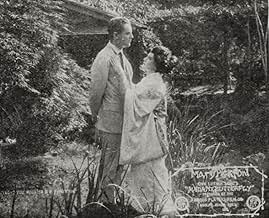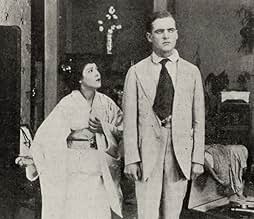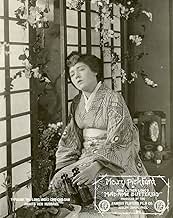Agrega una trama en tu idiomaThe story of a Japanese woman and the tragedy that ensues when she loves an American naval officer.The story of a Japanese woman and the tragedy that ensues when she loves an American naval officer.The story of a Japanese woman and the tragedy that ensues when she loves an American naval officer.
William T. Carleton
- The American Consul
- (as W.T. Carleton)
Ruth Gordon
- Minor Role
- (sin créditos)
- Dirección
- Guionista
- Todo el elenco y el equipo
- Producción, taquilla y más en IMDbPro
Opiniones destacadas
This film is shown often at the Plainfield Library in Plainfield, NJ. The film was shot in a Chinese Garden in Plainfield, NJ, built by a local businessman of the time. Some pieces of the gardens are still there.
I understand the film premiered at a local movie theater in Plainfield and Mary Pickford was there. Many silent films were made in the Plainfield, NJ area particularly in Westfield, NJ and Fort Lee, NJ at that time. D. W. Griffith was said to have liked the terrain of the area. But then he found out about the weather in California, and all movie making went west.
I understand the film premiered at a local movie theater in Plainfield and Mary Pickford was there. Many silent films were made in the Plainfield, NJ area particularly in Westfield, NJ and Fort Lee, NJ at that time. D. W. Griffith was said to have liked the terrain of the area. But then he found out about the weather in California, and all movie making went west.
Mary Pickford is Cho-Cho San, a beautiful and high-ranking Japanese woman who is sold in marriage to Navy Lieutenant B.F. Pinkerton (Marshall Neilan). After a while, he is ordered back to the US. There he marries his old sweetheart, while in Japan, Mary bears him a child.
It's a pure drama. Miss Pickford has little in the way of comedy. It's also from the period when she was attempting to prove her range by playing a variety of exotic roles: Italian, French, Dutch, Hindu... it would finish near the end of the following year, when the war in Europe made American roles more popular, and then she would begin to play juvenile roles, which were even more successful.
Originally a short story by John Luther Long based on his sister's stories about being a Methodist missionary in Japan, "Madame Butterfly" was first published in 1898. It was immensely popular. By 1904, Puccini's opera was a great success. I have little doubt that everyone was pleased to see Miss Pickford bring the role to the screen; this was an era when "yellow face" roles were not an issue.
However, I find it among the weakest of Miss Pickford's features. The lack of humor, as well as Sidney Olcott's static direction, don't help, despite the pretty set and costume designs. Then too, Miss Pickford was growing tired of the rapid rate of movie production, as Adolph Zukor worked her hard to make money on her astonishingly large salary. It would come to a head within a year, and in 1917, Cecil B. Demille would direct two of her movies.
It's a pure drama. Miss Pickford has little in the way of comedy. It's also from the period when she was attempting to prove her range by playing a variety of exotic roles: Italian, French, Dutch, Hindu... it would finish near the end of the following year, when the war in Europe made American roles more popular, and then she would begin to play juvenile roles, which were even more successful.
Originally a short story by John Luther Long based on his sister's stories about being a Methodist missionary in Japan, "Madame Butterfly" was first published in 1898. It was immensely popular. By 1904, Puccini's opera was a great success. I have little doubt that everyone was pleased to see Miss Pickford bring the role to the screen; this was an era when "yellow face" roles were not an issue.
However, I find it among the weakest of Miss Pickford's features. The lack of humor, as well as Sidney Olcott's static direction, don't help, despite the pretty set and costume designs. Then too, Miss Pickford was growing tired of the rapid rate of movie production, as Adolph Zukor worked her hard to make money on her astonishingly large salary. It would come to a head within a year, and in 1917, Cecil B. Demille would direct two of her movies.
This, of course, is the silent film version of David Belasco's Madame Butterfly, made shortly before this into the opera by Puccini. I saw it many years ago on late night TV in New York in the 60's I think. The stage play, and the opera were based upon the novella by Luther Long. The entire text of this is on the web and is most interesting in that Cio- Cio San does NOT commit hara-kiri at the end. Rather she tries to and screws it up and she, Sasuki and her little boy leave the night Pinkerton comes to deliver the bad news.
I find it impossible to give any sort of objective judgment of this film; firstly because standards of production have changed so drastically over the century since it was made, and secondly, because the opera's music and mise en scene so dominate our thinking. Nevertheless I found it fascinating. I cannot believe that I am the only person in the country that has seen it and stumbled onto this site!!!
I find it impossible to give any sort of objective judgment of this film; firstly because standards of production have changed so drastically over the century since it was made, and secondly, because the opera's music and mise en scene so dominate our thinking. Nevertheless I found it fascinating. I cannot believe that I am the only person in the country that has seen it and stumbled onto this site!!!
¿Sabías que…?
- ConexionesFeatured in Mary Pickford: A Life on Film (1997)
Selecciones populares
Inicia sesión para calificar y agrega a la lista de videos para obtener recomendaciones personalizadas
Detalles
- Tiempo de ejecución1 hora 1 minuto
- Color
- Mezcla de sonido
- Relación de aspecto
- 1.33 : 1
Contribuir a esta página
Sugiere una edición o agrega el contenido que falta

Principales brechas de datos
By what name was Madame Butterfly (1915) officially released in Canada in English?
Responda























